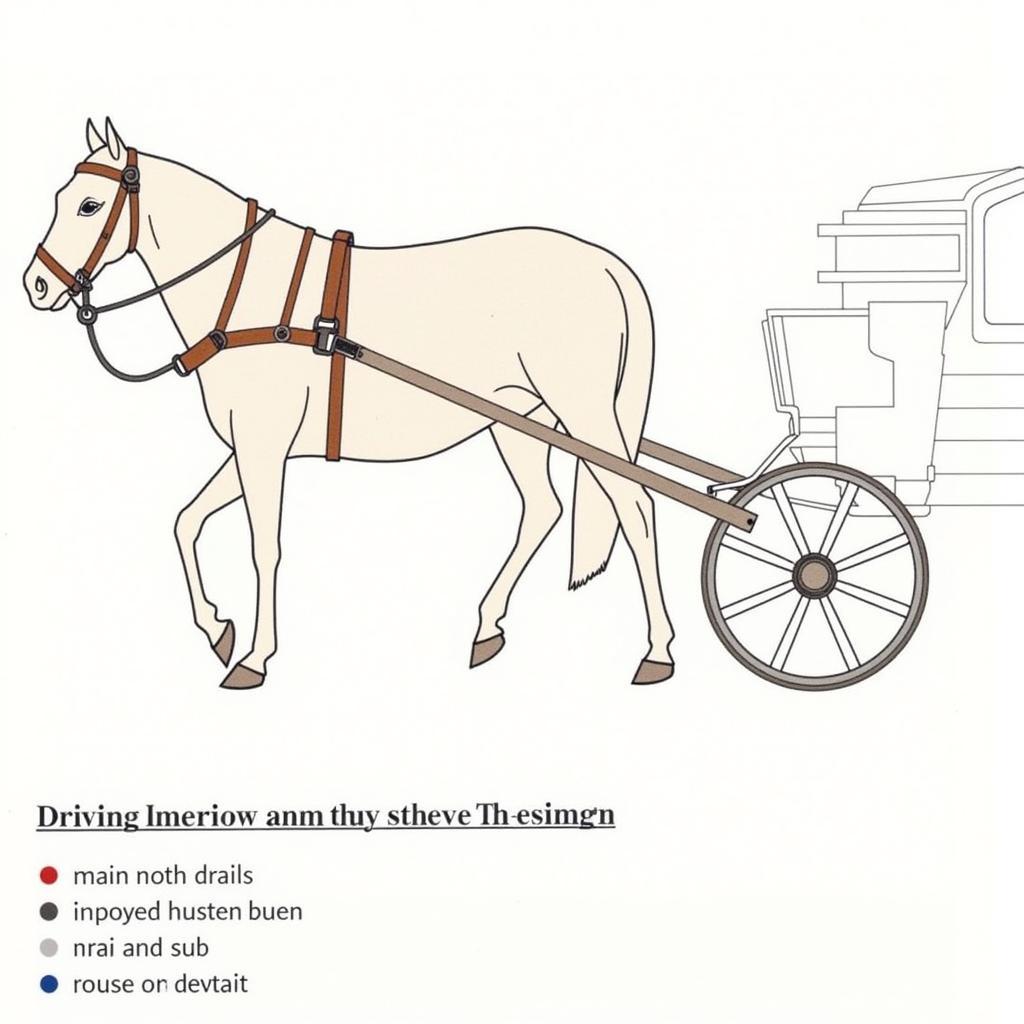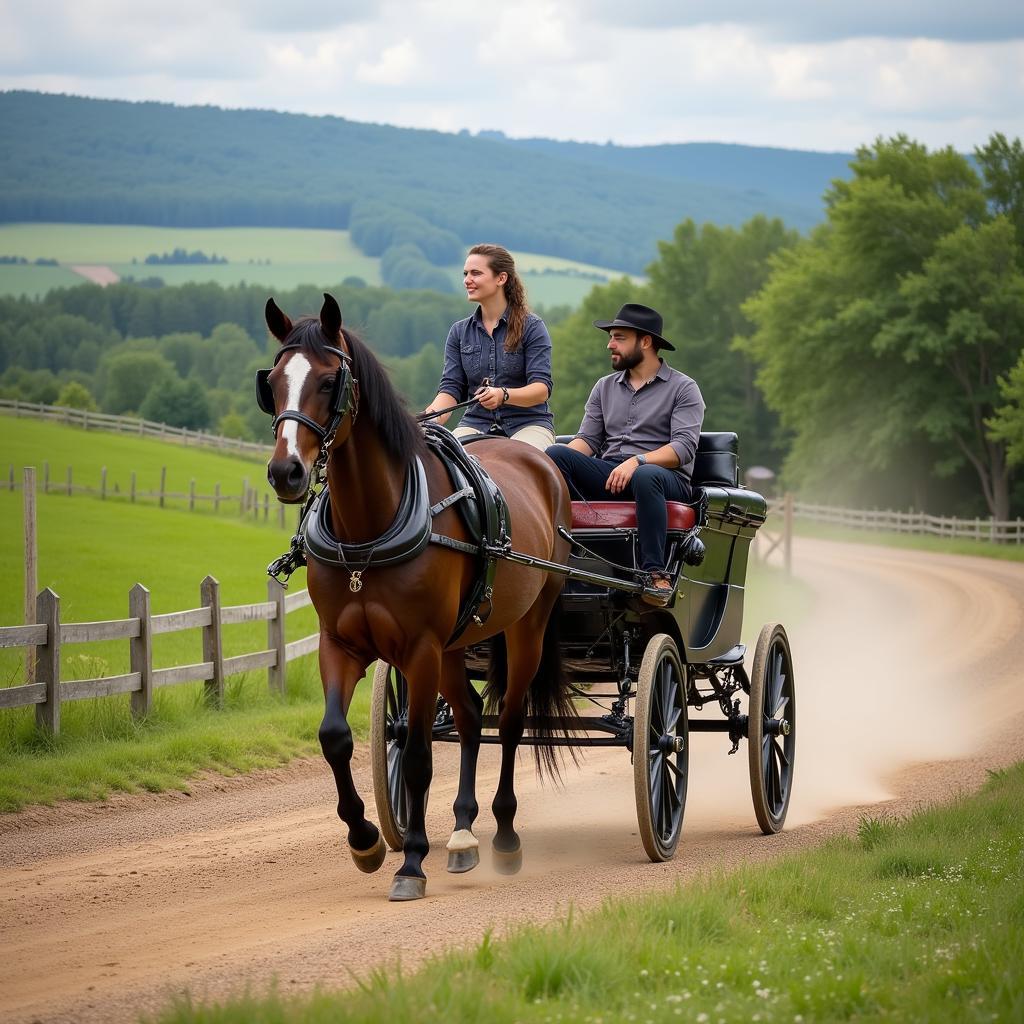Driving Lines For Horses are crucial for achieving smooth, controlled movements, whether you’re competing in driving trials, enjoying a leisurely carriage ride, or simply working your horse in harness. Understanding how to set up and execute proper driving lines is essential for both the horse’s comfort and the driver’s safety. This guide will delve into the intricacies of driving lines, offering practical advice and expert insights.  Diagram of Correct Driving Lines Setup
Diagram of Correct Driving Lines Setup
Understanding the Importance of Correct Driving Lines
Correct driving lines are the foundation of effective communication between horse and driver. They ensure that the horse understands and responds to the driver’s commands, preventing confusion and promoting a harmonious partnership. Properly adjusted lines distribute pressure evenly, preventing discomfort and potential injury to the horse. Moreover, well-maintained and correctly utilized driving lines are vital for safety, allowing the driver to maintain control and prevent accidents. For those interested in finding horses suitable for driving, check out our available driving horses for sale near me.
Different Types of Driving Lines
Various types of driving lines exist, each suited to different disciplines and driving styles. The most common types include:
- Liverpool Reins: Used for single horse driving, these reins offer precise control and are commonly seen in pleasure driving and showing.
- Overcheck Reins: Often used in pairs driving, overcheck reins run through rings on the bridle, providing additional leverage and control.
- Four-in-Hand Reins: Complex and requiring skillful handling, these reins are used for driving four horses simultaneously.
Choosing the right type of driving lines depends on the number of horses being driven, the specific discipline, and the driver’s experience level.
Setting Up Driving Lines for Horses
Setting up driving lines correctly is a meticulous process that requires attention to detail. Each component of the harness, from the cheek pieces for horses to the reins, plays a critical role.
Step-by-Step Guide to Harnessing a Horse for Driving
- Fit the Bridle: Ensure the bridle fits snugly and comfortably, with the bit positioned correctly in the horse’s mouth.
- Attach the Breastplate or Collar: This distributes the pulling force evenly across the horse’s chest or shoulders.
- Connect the Traces: The traces connect the harness to the vehicle and should be adjusted to the correct length.
- Attach the Reins: Ensure the reins are buckled correctly and run smoothly through the terrets and rings.
- Check for Proper Fit and Adjustment: Before hitching the horse to the vehicle, double-check that all components of the harness are properly fitted and adjusted.
“A properly fitted harness is like a well-tailored suit,” says renowned equine expert, Dr. Amelia Carter. “It should fit snugly but not restrict movement, allowing the horse to perform comfortably and efficiently.”
Common Mistakes to Avoid
- Over-tightening the Reins: This can cause discomfort and restrict the horse’s breathing.
- Uneven Rein Length: This can lead to uneven pressure and difficulty in steering.
- Ignoring Signs of Discomfort: Pay attention to your horse’s behavior and adjust the lines if they show signs of discomfort.
Maintaining and Caring for Driving Lines
Proper maintenance is essential for the longevity and safety of driving lines. Regular cleaning and conditioning will keep the leather supple and prevent cracking. Inspect the lines frequently for signs of wear and tear, replacing any damaged sections promptly. For insights into various horse breeds suitable for driving, explore our guide on big horses breeds. Learning about horse harness driving will further enhance your knowledge.
“Regular maintenance is key,” advises master carriage driver, Johnathan Stevens. “Just like you’d care for your riding tack, driving lines need attention to ensure they remain safe and functional.”
Conclusion
Mastering driving lines for horses is a continuous learning process that requires patience, practice, and attention to detail. By understanding the principles of correct driving line setup, maintenance, and usage, you can foster a stronger partnership with your horse and enjoy safe and enjoyable driving experiences. Remember, correct driving lines are not just about control; they are about communication, comfort, and safety for both horse and driver. If you are in Tennessee and looking for horses, you can find horses for sale in tn.
 Horse and Carriage Driving through Scenic Landscape
Horse and Carriage Driving through Scenic Landscape
FAQ
- What are the different types of driving lines?
- How do I adjust driving lines correctly?
- What are the common mistakes to avoid when setting up driving lines?
- How do I maintain my driving lines?
- Where can I find horses suitable for driving?
- What are the benefits of using proper driving lines?
- What are the safety considerations when driving horses?
For any assistance, please contact us at Phone: 0772127271, Email: [email protected] or visit our address: QGM2+WX2, Vị Trung, Vị Thuỷ, Hậu Giang, Việt Nam. We have a 24/7 customer support team.